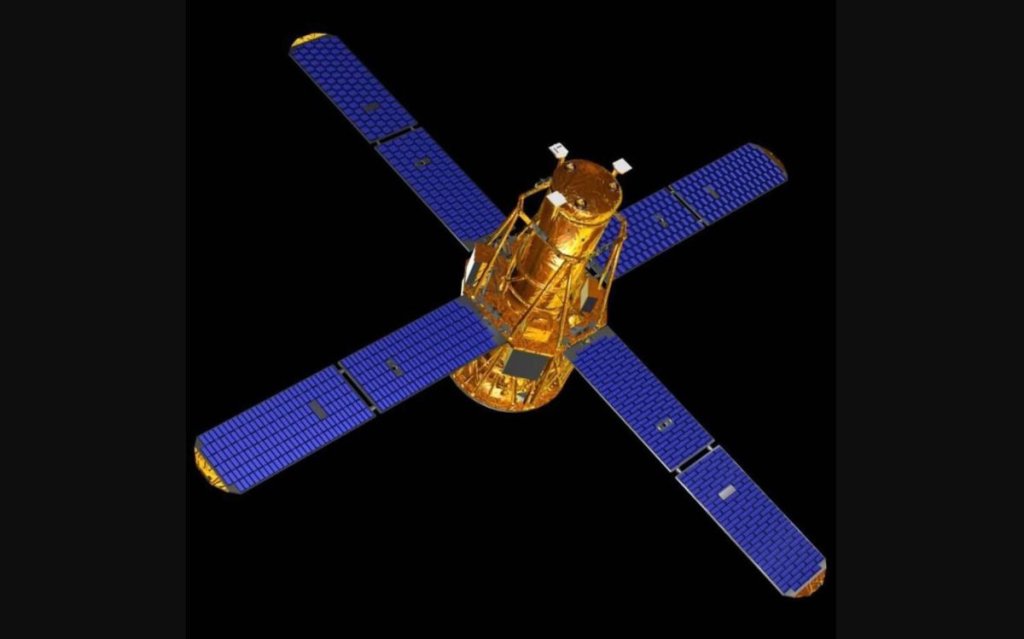
Dead NASA satellite will crash to Earth this week (Image Credit: Space.com)
A dead NASA spacecraft will come crashing back to Earth in the next few days, experts say.
NASA’s RHESSI satellite, which studied the sun from 2002 until its decommissioning in 2018, is expected to reenter Earth’s atmosphere around 9:30 p.m. EDT on Wednesday (April 19; 0130 GMT on April 20), plus or minus 16 hours, according to the latest estimates by the U.S. military.
RHESSI (short for “Reuven Ramaty High Energy Solar Spectroscopic Imager”) isn’t a huge satellite. It weighs just 600 pounds (270 kilograms), and the majority of that mass will be converted to ash and vapor during RHESSI’s death dive, NASA officials said.
However, “some components are expected to survive reentry,” agency officials wrote in an update on Monday (opens in new tab) (April 17). “The risk of harm coming to anyone on Earth is low — approximately 1 in 2,467.”
Related: Getting space junk under control may require an attitude shift
RHESSI’s coming plunge is another reminder that Earth orbit is an increasingly crowded and dangerous place.
More than 30,000 pieces of orbital debris are currently being tracked by global space surveillance networks, for example. But there are many, many more that are too small for us to keep tabs on.
The European Space Agency estimates (opens in new tab) that about 1 million objects between 0.4 inches and 4 inches (1 to 10 centimeters) wide are whizzing around our planet at the moment. And the approximate number of pieces between 0.04 inches (1 millimeter) and 0.4 inches is truly staggering — 130 million or so.
Even these tiny shards can do serious damage if they hit a satellite or a crewed spacecraft , given their tremendous velocities: In low Earth orbit, where the International Space Station and many other craft fly, objects move at about 17,500 mph (28,160 kph).
And in-space collisions generate many more pieces of space junk, which could lead to more collisions down the road. If enough of those happen, we’d end up with a dreaded cascade known as the Kessler Syndrome, which could seriously hamper our ability to explore and utilize space.
The RHESSI satellite launched to low Earth orbit aboard a Pegasus XL rocket in February 2002. The spacecraft studied solar flares and coronal mass ejections using its single science instrument, an imaging spectrometer that recorded X-rays and gamma rays.
“During its mission tenure, RHESSI recorded more than 100,000 X-ray events, allowing scientists to study the energetic particles in solar flares,” NASA officials wrote in Monday’s update. “The imager helped researchers determine the particles’ frequency, location and movement, which helped them understand where the particles were being accelerated.”
RHESSI will be far from the biggest hunk of space junk to fall to Earth uncontrolled when it comes down. Last November, for instance, the 23-ton (21 metric tons) core stage of a Chinese Long March 5B rocket came crashing back to Earth about five days after it launched the third and final module for the nation’s Tiangong space station.
That was the fourth Long March 5B mission to date, and all four have featured uncontrolled reentries of the massive core stage.
Mike Wall is the author of “Out There (opens in new tab)” (Grand Central Publishing, 2018; illustrated by Karl Tate), a book about the search for alien life. Follow him on Twitter @michaeldwall (opens in new tab). Follow us @Spacedotcom (opens in new tab), or on Facebook (opens in new tab) and Instagram (opens in new tab).





